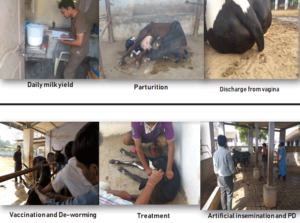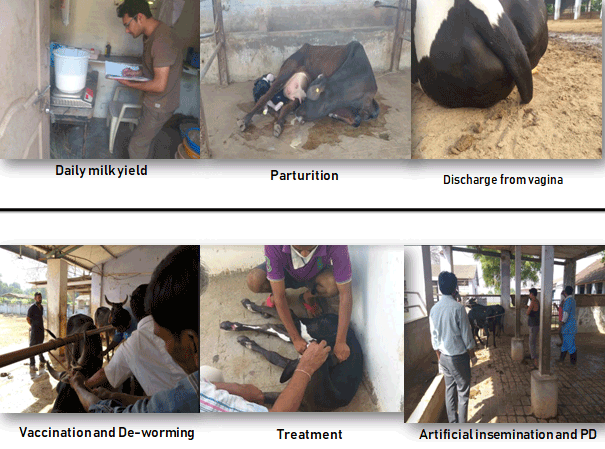Dairy farm Data Recording Impact Analysis on Socio-Economic Aspects of Business
Shilpa Tewari, CS Mukhopadhyay*
Ph.D Scholar. College of Animal Biotechnology, Guru Angad Dev Veterinary and Animal Sciences University, Ludhiana – 141004
*Associate Professor, College of Animal Biotechnology, Guru Angad Dev Veterinary and Animal Sciences University, Ludhiana – 141004
Email:csmbioinfo@gmail.com
Summary
A dairy farm record is a file or a document that is used to keep account of various activities, materials, and events, regarding the farm operations, while record keeping is writing or documenting those activities on a recording machines or materials. Record keeping may be a required element of excellent livestock business management. It is kept for providing data for state administrative and extension purposes, livestock management decisions, assisting in financial planning decisions, and evaluating overall activities of the dairy farm.
There is variety of dairy records a farmer should keep to run a successful farm business. These are records of Identification of cattle, health records, record of agricultural inputs, production records, financial records, records of farm implements and equipment, records of animal feeds, daily farm records, vehicle and workers records. Record-keeping are often accomplished through a variety of methods, from a basic manual (hand) record-keeping method to an elaborate computerized system. Selecting these methods depends on the expected use of the records, herd size, type of farms and the individuals who own the farm.
The first officially recognized recording system in Denmark in 1895, when milk recording organizations were formed.
Aspects of Dairy Management
Record-keeping often accomplished through a various methods, from a basic manual (hand)
record-keeping method to an elaborate computerized system. There is no “best” record keeping system for all circumstances, but, at minimum, a farm records system should deliver necessary and accurate information, fit into the farm framework or organization, and be available in a form to aid decision-making.
Manual (Hand System)
A large number of hand systems are available. These are comprised of colour coding, individual cow record charts or card files, manuals, tags and record books. These records are kept in a filing tray or folder for ease of portability. Individual cow record chart regardless of their age, numerical cow identification order, charts helps the dairy manager with a history growth, breeding and sire information used, vaccinations and health, calving’s, and milk production records of the animals, colour-coded file signals to identify the reproductive status and other information, milk and insemination records. It is time consuming and tedious to analyse and to use its results for further action. This system is typically related in small herd size farms.
Computerized Record-Keeping System
Historically, many farm managers have found keeping and analyzing farm records a challenge.
However, a variety of challenges have been addressed through computerized record-keeping systems. A computer allows the dairy producer to have management reports available for an individual cow or the herd or either the group of cows . These reports then allow the effectiveness and quality of management to be improved by using information in a condensed form. These management reports should cover all areas of herd management, including nutrition, reproduction, inventory, production, replacements, financial and health.
Computerized record-keeping system utilizes dairy management softwares which may be categorized into three different types: a simple event and record display program, a fully-featured management program and an integrated management program.
A simple event and record help to display program to keep and view the records. And some fully-featured management program, which not only keep records, but also analyzes them. While some integrated management program, incorporated with real time sensors and monitors such as milk flow meters and feeding systems. These sensors and monitors help in management about the feeding patterns of individual and cows milk production or herd to the recording system. Computerized record-keeping system it has advantages of allowing information to be summarized more easily, printing the reports more easily and handling huge data.
The data should allow dairy producers to determine how they compare to other dairy producers so they can determine the weak and strong points of their operation and allows dairy producers to regulate the areas they can most improve in their herd management.
Advantages of record keeping at farm
• Helps in arranging pedigree and history record of animals.
• Helps in evaluating the past records and designing better breeding plans for selecting superior parents, check inbreeding and helps in better additional and culling practices.
• Helps in analysing feeding cost and benefits from animal product outputs. Hence helps to formulate economic feeding strategies for optimal productions.
• Helps in detection of abnormal conditions or disease status of the herd that leads to loss in body weight, loss in milk production etc.
• Helps in analysis of the commonly occurring diseases in the herd and time precautionary measures like deworming, vaccination etc.
• Helps in fixing proper prices for purchase and sale of animas.
• Helps in management of herd.
• Helps in determining the income and expenditure (economics) of dairy farm.
• Helpful in comparing the efficacy of labour and herd with other farms.
• To equate the herd performances in different years to adjust the amount of profit/loss and setting future goals/directions for the farm.
Farm records are kept for all or some of the following reasons:-
To Assist in Financial Planning Decisions
Financial records, in more detail can be used for enterprise analysis, cash flow planning, and other purposes. It is also useful to analyse the farming activities to decide which of ventures were more profitable and which did not pay and should be either made more efficient or eliminated. Farm managers use records to construct cash flow, balance sheets, and income statements, and other financial aids for making more knowledgeable decisions. In dairy farm, controlling labour is important part of financial decision making such as a wages book recording days worked, money owed, wages paid, leave and other activities.
To Provide Data for Government Administrative and Extension Purposes
First, and most obvious use of record in most developed countries is to be in compliance with state and federal regulation and permit requirements. This is an essential requirement of record keeping but should not be the sole reason, and a record system can be designed which satisfies the receiver and is also useful for other purposes.
To Assist in Livestock Management Decisions
Records of individual animals and groups of animals, their production, feed use, health, and other records are important in evaluating efficiencies by calculating production per cow, feed cost per liter of milk, Production per hectare, calving interval, conception rate, culling rate, and stocking rate that help to make a decision on management of the herd or individual.
According to the benefits
that farmers gained by keeping records were: knowing expense, knowing income, managing income and expense more effectively, changing saving habit, communicating more with family members, and trust more among family members.
Animal identification
A good herd recording system will include identification of each calf as soon as possible after birth. In addition to the identification name or number, the calf ’s birth date, its size, name and its sire and dam’s names should be recorded on a simple identification record. Such information is useful to dairy farmers when: heifers are evaluated for breeding and superior bulls must be chosen, a sire is to be selected and the farmer wishes to avoid in-breeding, evaluating overall herd reproduction and determining the age of heifers at first heat, knowing the age at which a heifer should be targeted for breeding, comparing genetic lines across an area (with other dairy farmers) to determine which animals to cull,
determining which animal should be culled on the basis of age.
Herd breeding records
A farmer with records based on identified cows can improve his breeding management by being able to determine such matters as: the date at which to dry a cow off; knowing when a cow should deliver a calf; highlighting poor insemination or bull services; establishing breeding dates and feeding programs; identifying calf, sire and dams; and determining the date for pregnancy testing. Breeding records must be up-to-date and easily accessible. They should be kept on a computer or in a dry and clean place within the dairy shed in a position which the farmer passes each day and can easily stop to update records.
Herd breeding records should include: the identification of an animal including its birth date, name of sire and dam, calving dates and comments, heat dates and comments, earliest breeding date, pregnancy examination, service information, drying off date, any additional remarks.
Milk production records
Milk production records help the farmer determine which animals are carrying down the average yield and income from the herd. Good milk production records can support to raise milk production from an individual cow and a herd through specific management for individual animals. The more often individual daily milk production (and milk composition) data are recorded, the better. Daily herd milk yields and milk composition/quality data should be easy to access and record. Seasonality of milk production needs to be quantified to develop the most appropriate feeding strategies to address troughs in monthly milk yields.
Health records
With the use of records, doctor can gain further information about the probable causes of ill health or poor reproduction in an individual animal to compensate for lack of familiarity with an individual arrival. Information concerning quality of milk, milk yields, dates of last change of status in reproductive and lactation terms, and other general information. Treatment information and health issues can also be recorded for individual stock on-farm. As well as recording doctor visits (date, purpose, diagnosis and treatment), vaccination details (type and date) and cow and calf mortalities, records are useful information in disease management.
Feeding records
These can vary from simple records of when feed was purchased and for which category of stock, through to details of changes in feeding programs (such as feed types and daily quantities fed per cow). The more detailed the feeding records, the better the ability to assess feeding efficiency (milk produced per unit feed consumed) on the farm.The best way of recording such information is using a daily diary kept in the office where changes in herd and feeding management can be routinely included. This diary could also be used to document appointments or other planned important farm activities.
Daily Farm Records
These are the records of all important daily activities and events that happen on the farm. These records help the farmer keep track of past farming activities and plan for future activities. It is also useful to record unusual situations and matters in the farm.
Records of Farm Implements and Equipment
This is used to keep an inventory of all the equipment on the farm and their quantity. It can also contain the date of purchase of the equipment and sometimes their description. Especially useful to manage the equipment’s in the farm in a good manner and to save from loss.
Workers and Vehicle Records
Workers record is used to keep the record of staffs. It is also known as labour record while vehicle record is a record of all vehicles used on the farm, petrol and oil used, and also any repairs and servicing and the dates of the repair or servicing.

https://images.app.goo.gl/ArnqocbN1quLrr6X9
Farm records are mirror of farm and its importance should not be ignored.
Conclusion
Record keeping is a necessary element of good livestock business management. With no written records, farmers have to depend on their memory while making decisions regarding their farm
practices. But, memories can become unreliable after a few days, months or years. The ultimate purpose of a recording system is to improve the level of herd performance by achieving things better, running the farm more competently, or reducing the possibility of poor future performances.


